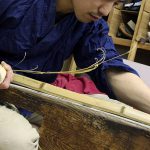
The kote protects the hands and arms. It has a meticulous design in order to protect the hands against striking impact while allowing them to hold the shinai flexibly. The basic structure of the kote consists of the kote-gashira (fist cover), tenouchi (palm cover), , and the kote-tsutsu (wrist cover). Here I will explain about each part.

The kote-gashira covers the fist. The materials are deer skin, synthetic leather and indigo-dyed cotton. Some fist covers are sewn with a technique called “kagari-nui” (looping) to allow the fingers to move flexibly. It prevents the hand from being fixed and allows it to open up freely. The end of the kote is made so only the thumb is separate from the other fingers. Kote with a 5-finger split may be available in the market, but for the sake of fairness this is not allowed in matches.
On the other side there a thin leather called “tenouchi” (palm cover). Expensive ones are made of deerskin or cowhide, while cheaper ones are made of synthetic leather. The tenouchi has a very smooth texture to allow the player to hold the shinai firmly, but if you use it for a long time the friction against the shinai will give it many scratches.
The kote-tsutsu covers the wrist to about half way up the arm. The “yuko” strike on the kote is awarded when a player successfully strikes the kote-tsutsu.
The kote collects a lot of sweat from the hand and can easily get heated. It is an equipment that can become odorous. It is important to dry it after use so bacteria do not propagate. This can be said of all equipment, not just the kote. These days you can buy kote that can be washed, so that may be a good option too.










